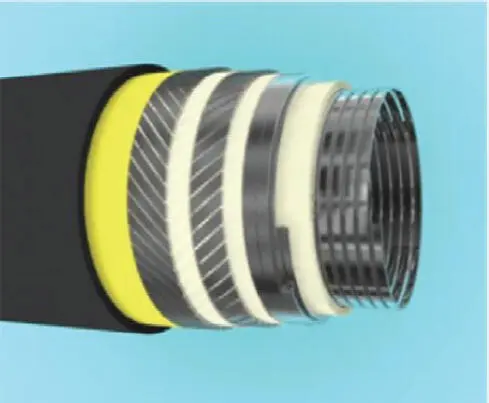3
Structural Design of High Pressure Flexible Pipes of Different Internal Diameter
3.1 Introduction References
Accurate prediction of the pipe’s burst pressure is an important subject in the integrity assessment of oil and gas transmission application. As we know, flexible pipes are manufactured with several layers; a typical structure is shown in Figure 3.1. From the inside to the outside, it consists of the following:
Carcass: an inner carcass with S profile providing resistance to collapse.
Internal pressure sheath: an internal plastic sheath providing fluid leak proofness. Pressure armor: a Zeta-shaped metallic layer wound at short pitch providing support for the internal plastic sheath and part of the resistance to the radial forces.
Anti-wear layer: Prevent contact and friction between metal layers and can’t resist loads.
Tensile armor: an even number of metallic layers wound at long pitch providing resistance to the axial forces and also partly to the radial forces.
Outer sheath: an external plastic sheath for protection against corrosion.
Due to the function of each layer is independent, the factory makes different layers combination to adapt to its own serving condition.
To the date, there have been published some works focused in burst analysis of flexible pipes, both numerical and analytical models are studied. For the study of burst pressure, Fernando et al . [1] studied the pressure layer subjected to internal pressure using two models: a 2D axisymmetric one, including only the internal pressure loading, and a three-dimensional (3D) model, including pressure layer manufacturing simulation and also the internal pressure layer. Neto et al . [2] proposed a linear analytical formulation assuming that the pressure armor behaves exactly as a thin- walled cylinder considering the equivalent thickness of the profile of the pressure armor. A most simplified analytical model was presented by Oliviera et al . [3] to estimate the burst strength considering its axial and circumferential deformation. Zhu et al . [4] proposed an average shear stress yield criterion, and compared the predicted values with the experimental results. It was found that the predicted values of Mises criterion were in good agreement with the actual values of the materials. Chen [5] analyzed the burst failure mechanism of flexible pipe by two-step method, first step is to study the pressure armor’s behavior and second step is to study the tensile armor after the pressure armor fails, and obtained a simple burst pressure formula by using ring compression theory. Furthermore, Fergestad [6] used the curved beam theory to consider the resistance of armor layers subjected to internal pressure, and used the ultimate strength as the failure criterion. Both of them use a simple radial and axial equilibrium relationship and only consider the resistance of the axial stress of the helix to internal pressure. On the basis of researches, Kebadze [7] deduced and summarized the theoretical solution models of different kinds of layers and combined them into various solutions to carry out the theoretical solution of the model.

Figure 3.1 Structure of flexible pipe.
Concerning the structural analysis of flexible pipes subjected to internal pressure, several researchers made their contribution to this field. In this chapter, according to the Kebadze’s research, the theoretical analysis considers the material nonlinearity of armor layers and geometrical nonlinearity in the prediction of burst. Verifying the correction of the theoretical model by Abaqus, it is promising to design cross-section of pipes by mathematical software conveniently.
Industry practice requires several types of flexible riser configurations typically used in conjunction with floating production/loading systems. Figure 3.1illustrates these six main types of flexible riser configurations. The feasible configurations differ in the use of buoyancy modules and the methods of anchoring to the seafloor. Configuration design considerations include several factors such as water depth, host vessel access/hang-off location, field layout such as the quantity and types of risers and mooring layout, environmental data, and host vessel motion characteristics.
Before the theoretical deduction, several simplified hypotheses are made ahead:
1 1) All materials are homogeneous and isotropic and have linear elastic behavior.
2 2) The geometrical deformations are small.
3 3) Thickness variations in the layers are assumed to be uniform in each layer.
4 4) There is no contact between adjacent tendons in the same helical layer.
5 5) The layers remain in contact.
6 6) No gap between adjacent layers is allowed in the unstressed (initial) state.
7 7) All layers at all cross-sections present the same twist per unit of pipe length and the same elongation.
Cylindrical components in flexible pipes are mainly used as barriers to liquid. Internal tubes transport the hydrocarbons while as external sheaths protect the steel from sea water and corrosion. Sometimes, they are used at an intermediate position between steel layers in order to reduce wear and friction. The thin tube theory with the consideration of radial strain is applied to the cylindrical layers.
The internal strain energy is
(3.1) 
where ε 1, ε 2, ε 3and γ 12are strain components, σ 1, σ 2, σ 3, and τ 12are corresponding stress components. The related parameters definition is shown in Figure 3.2.
Considering the global elongation, torsion, and volume change of the cylindrical components under pressure, the work of external forces is expressed by
(3.2) 
where Pi , Po , Δ Vi , Δ Vo denote internal pressure and external pressure and the changes in internal volume and in external volume, respectively.
Using the principle of virtual work, which implies equating the variation of the external work to the variation of the internal energy, the equilibrium equations are derived.

Figure 3.2 Cylindrical mathematical parameters definition.
(3.3) 
To calculate this equation, the matrix form of stiffness equations for the thin tube theory is derived:
(3.4) 
The helix component is main force resistant structure of flexible pipe, which has an important influence on the mechanical properties of pipe. For pressure armor, it is necessary to simplify the section. In order to keep the radial continuity, the same thickness of the original section is used. In addition, the axial stiffness of the helix is mainly considered, so keep the area same as the original section. The exact formula for axial strain of a helical element was derived by Knapp [8]. In order to obtain a linear equilibrium equation of helical tendons, the exact formula is simplified as
Читать дальше


















